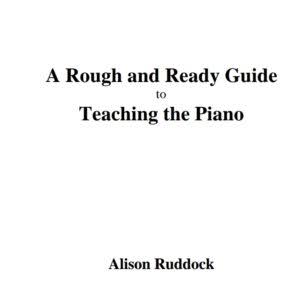A Rough and Ready Guide to Teaching the Piano – Free
₦0.00
A Rough and Ready Guide to Teaching the Piano
Alison Ruddock
A Rough and Ready Guide to Teaching the Piano is a comprehensive guide to teaching the piano, covering various aspects of piano playing and teaching from beginner to advanced levels.
4 Items sold in last 3 months
Add ₦300,000.00 to cart and get free shipping!
12 People watching this product now!
Categories: Ebook, Music ebooks, Musical Instrument, Piano, Piano E-books 
Report Abuse 
Description
- A Rough and Ready Guide to Teaching the Piano
Alison Ruddock
A Rough and Ready Guide to Teaching the Piano is a comprehensive guide to teaching the piano, covering various aspects of piano playing and teaching from beginner to advanced levels.
Reviews (0)
Rated 0 out of 5
0 reviews
Rated 5 out of 5
0
Rated 4 out of 5
0
Rated 3 out of 5
0
Rated 2 out of 5
0
Rated 1 out of 5
0
Be the first to review “A Rough and Ready Guide to Teaching the Piano – Free” Cancel reply
Questions & Answers
Loading...
Shipping & Delivery
Vendor Info
Vendor Information
- Store Name: J. Sam Industry
- Vendor: J. Sam Industry
- Address:
Nigeria
Kwara - 5.00 rating from 1 reviewRated 5.00 out of 5 based on 1 customer rating
More Products
Rhythm 5A TAMA Mate Maple Drum Hickory 2B 7A HRM 5B Stick
SKU:
rhythm-5a-tama-mate-maple-drum-hickory-2b-7a-hrm-5b-stick
Rated 0 out of 5
Iron Cobra Drum Pedal
Rated 0 out of 5
Foreign WLA-210 Sub Active Loudspeaker
Rated 0 out of 5
Shure Professional Wireless Microphone With Rechargable Battery And Charger And USB Charging Jack
Rated 0 out of 5
Product Enquiry
Product Enquiry
Related products
Acoustic GUitar – Natural with bag and strap
SKU:
acoustic-guitar-natural
Rated 0 out of 5
Dvion microphone ACT 9090U wireless Microphone
SKU:
dvion-microphone
Rated 0 out of 5
New Adjustable Music Stand
SKU:
new-fold-able-music-stand
Rated 0 out of 5
New Sennheiser EW 135P G4
SKU:
new-sennheiser
Rated 0 out of 5
New VIRGIN FULL RANGE BLACK SPEAKER
SKU:
new-virgin-full-range-black-speaker
Rated 0 out of 5
NEW YAMAHA FULL SIZE GUITAR
SKU:
new-yamaha-full-size-guitar
Rated 0 out of 5
Original Yamaha Keyboard/Piano New Adaptor
SKU:
yamaha-keyboard-piano-new-adaptor
Rated 0 out of 5
Rechargeable Public Address System
SKU:
rechargeable-public-address-system
Rated 0 out of 5
YAMAHA DRUM SET
SKU:
yamaha-drum-set
Rated 0 out of 5
Yamaha Psr280 – UK Used
SKU:
yamaha-psr280-uk-used-cheap-price
Rated 0 out of 5


















Reviews
Clear filtersThere are no reviews yet.